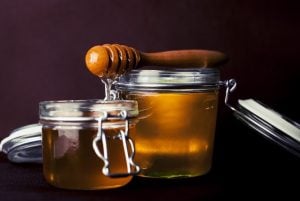If you are thinking about setting up an emergency pantry in your house, that is a laudable goal. However, you need to keep in mind that selecting the right foods is just part of what it takes to be a successful food prepper. It is just as important to pay close attention to storage methods and be aware of things that can decrease the shelf lives of products or even render them useless.

Shelf life is defined in two ways:
Best used by: The duration foods retain most of their original taste and nutrition.
Life sustaining: The duration foods can be stored and still be edible.
Storage Tips
The four primary factors that can interfere with proper food storage are temperature, moisture, oxygen, and light. Of course you also need to keep ants and weevils out of food by using airtight containers. Here are a few helpful tips to ensure that your pantry food endures as long as its stated shelf life.
Store foods at 75°F/24°C or lower to retain nutrition, however, keep in mind that temperatures between 50°F to 60°F are optimal.
Store food in a dry place away from any moisture. Too much moisture promotes an environment in which microorganisms can grow, causing food to spoil.
Likewise, oxygen can cause foods to deteriorate and promotes the growth of microorganisms—especially in fats, vitamins, and food colors. Use oxygen absorbers when dry packing your own food products.
Too much light can be just as damaging to food as temperature, moisture, and oxygen. Keep long term food storage in low light areas to ensure the longest shelf life.
Food with Longest Shelf Life
You cannot do much better than indefinitely, which means forever, as long as you take the time to properly set up your food pantry. Believe it or not, some of the following staples and foods have a potentially endless shelf life, while others can last as long as 30 years!
Honey: According to the National Honey Board, honey can last for centuries if stored in a sealed jar. Perhaps you’ve discarded honey because it crystalized, thinking it was inedible. The thick, sugary gunk at the bottom may be unappealing, but it is perfectly safe to eat. Honey can be decrystalized by bringing water to boil on the stove or campfire. Remove the pan from the heat source and then place the jars of honey into the hot water. Let the water cool until it reaches room temperature and if there is any crystallization remaining, repeat the process. Experts recommend not using a microwave because it can destroy honey’s beneficial enzymes and properties.
Salt: While you certainly aren’t going to eat salt as a food by itself, it lasts forever and you’ll be glad you have it. Salt is made of sodium chloride and your body requires it for blood, sweat, digestive fluids and efficient nerve transmission. Rapid loss of sodium from the body can cause a low concentration of sodium in the blood, a condition known as hyponatremia. In addition, salt is a food preservative, a flavor enhancer, and has other benefits. Mixed with water, it can be used to clean wounds and prevent bacteria. Gargling with a saltwater solution can soothe sore throats, canker sores, and promote overall oral health.
Sugar: In normal situations, you typically are not going to eat sugar by itself. Even though experts have issued countless warnings about the negative health implications of eating too much sugar, it is an instant source of energy due to its high glucose and fructose content. Furthermore, sugar is a useful first aid tool because it draws water from wounds and forms a type of dressing. Just make sure the wound has stopped bleeding before adding sugar, because it can actually increase the flow of blood.
Canned or Dried Beans: Beans are the ultimate survival food because they are high in protein, easy to store, and come in so many varieties. A simple meal of rice and beans provides all nine essential amino acids. You cannot go wrong stockpiling several cans of varieties you like—kidney, black, white, pinto, lima, navy, garbanzo, etc.
Rice: White, wild, arborio, jasmine and basmati rice all have an indefinite shelf life, as long as they stay contaminant free. The only rice that does not have a long shelf life is brown, due to its higher oil content. As mentioned above, the duo of rice and beans is a tasty and nutritious meal.
Powdered Eggs: Convenient to store, easy to prepare, and with a shelf life of up to 25 years, powdered eggs can be used for a wide array of recipes that call for eggs including baked goods, omelets, and casseroles. They can be used without rehydration when baking, or can be rehydrated to make dishes such as French toast. Powdered eggs not only last 150-300 times longer than fresh eggs, but they also retain their nutritional value for the length of the stated shelf life.
Freeze-Dried and Dehydrated Foods: Available in an assortment and variety of bulk sizes, sealed, individual Mylar pouches of freeze-dried fruit can last up to 20 years. Vegetables are also available in an assortment of individual packets in different bulk sizes, with a shelf life of up to 25 years. They require very little water and just minutes of soaking before eating—a super convenient, quick, and easy solution. Studies have shown that freeze-dried and dehydrated foods retain calories and nutrition when properly packaged and sealed, even past their designated use by date. If disaster strikes, these foods can be lifesavers!
This article was originally posted in News by Wise Blog Team on the Wise website on August 18th, 2016
